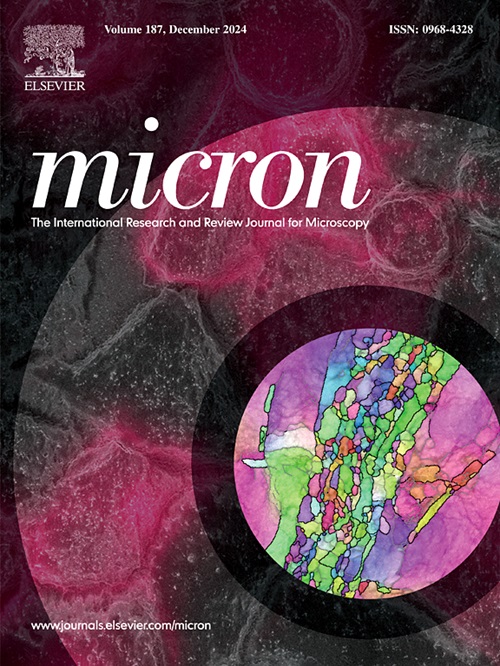两种转移的故事:聚二甲基硅氧烷粘弹性冲压和六方氮化硼的加热聚双-A 碳酸酯转移的表征
IF 2.5
3区 工程技术
Q1 MICROSCOPY
引用次数: 0
摘要
二维(2D)材料应用广泛,从异质结构电子学到纳米流体学和量子技术。为了有效利用二维材料实现这些目标,必须将它们转移并集成到复杂的设备几何结构中。在本报告中,我们研究了转移二维材料的两种传统方法:使用聚二甲基硅氧烷(PDMS)的粘弹性冲压和使用聚双碳酸酯(PC)的加热转移。我们使用这两种方法将机械剥离的六方氮化硼薄片转移到氮化硅(SiNx)基底上,并使用原子力显微镜(AFM)、像差校正扫描透射电子显微镜(AC-STEM)和电子能量损失光谱(EELS)对转移结果进行表征。我们发现,这两种转移方法都能得到残留量显著且相当的薄片(在我们对八个样品进行研究的限制范围内)。对 EELS 图谱的定性分析表明,这两种转移方法产生的残留物都由硅、碳和氧组成。AC-STEM 图像的定量分析显示,与 PC 转移(41 % ± 4 %)相比,PDMS 转移的残留物覆盖面积平均略低(31 % ± 1 %)。这项工作强调了改进现有转移协议的重要性,以适应对清洁材料至关重要的应用,同时也强调了对清洁二维材料的可靠方法的需求。本文章由计算机程序翻译,如有差异,请以英文原文为准。
A tale of two transfers: characterizing polydimethylsiloxane viscoelastic stamping and heated poly bis-A carbonate transfer of hexagonal boron nitride
Two-dimensional (2D) materials have many applications ranging from heterostructure electronics to nanofluidics and quantum technology. In order to effectively utilize 2D materials towards these ends, they must be transferred and integrated into complex device geometries. In this report, we investigate two conventional methods for the transfer of 2D materials: viscoelastic stamping with polydimethylsiloxane (PDMS) and a heated transfer with poly bis-A carbonate (PC). We use both methods to transfer mechanically-exfoliated flakes of hexagonal boron nitride onto silicon nitride (SiNx) substrates and characterize the resulting transfers using atomic force microscopy (AFM), aberration-corrected scanning transmission electron microscopy (AC-STEM) and electron energy loss spectroscopy (EELS). We find that both transfer methods yield flakes with significant and comparable residue (within the limitations of our study on eight samples). Qualitative interpretation of EELS maps demonstrates that this residue is comprised of silicon, carbon and oxygen for both transfer methods. Quantitative analysis of AC-STEM images reveals that the area covered in residue is on average, slightly lower for PDMS transfers (31 % ± 1 %), compared to PC transfers (41 % ± 4 %). This work underscores the importance of improving existing transfer protocols towards applications where cleaner materials are critical, as well as the need for robust methods to clean 2D materials.
求助全文
通过发布文献求助,成功后即可免费获取论文全文。
去求助
来源期刊

Micron
工程技术-显微镜技术
CiteScore
4.30
自引率
4.20%
发文量
100
审稿时长
31 days
期刊介绍:
Micron is an interdisciplinary forum for all work that involves new applications of microscopy or where advanced microscopy plays a central role. The journal will publish on the design, methods, application, practice or theory of microscopy and microanalysis, including reports on optical, electron-beam, X-ray microtomography, and scanning-probe systems. It also aims at the regular publication of review papers, short communications, as well as thematic issues on contemporary developments in microscopy and microanalysis. The journal embraces original research in which microscopy has contributed significantly to knowledge in biology, life science, nanoscience and nanotechnology, materials science and engineering.
 求助内容:
求助内容: 应助结果提醒方式:
应助结果提醒方式:


